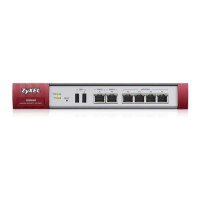Chapter 26 Application Patrol
ZyWALL ATP Series User’s Guide
500
The following table describes the labels in this screen.
Table 202 Configuration > Security Service > App Patrol > Action
LABEL DESCRIPTION
Show Filter/Hide
Filter
Click Show Filter to display IPv4 and IPv6 (if enabled) security policy search filters.
IPv4 / IPv6
Configuration
Use IPv4 / IPv6 search filters to find specific IPv4 and IPv6 (if enabled) security policies based on
direction, application, user, source, destination and/or schedule.
From / To Select a zone to view all security policies from a particular zone and/or to a particular zone.
any means all zones.
IPv4 / IPv6
Source
Type an IPv4 or IPv6 IP address to view all security policies based on the IPv4 / IPv6 source
address object used.
• An IPv4 IP address is written as four integer blocks separated by periods. This is an example
IPv4 address: 172.16.6.7.
• An 128-bit IPv6 address is written as eight 16-bit hexadecimal blocks separated by colons
(:). This is an example IPv6 address: 2001:0db8:1a2b:0015:0000:0000:1a2f:0000.
IPv4 / IPv6
Destination
Type an IPv4 or IPv6 IP address to view all security policies based on the IPv4 / IPv6 destination
address object used.
• An IPv4 IP address is written as four integer blocks separated by periods. This is an example
IPv4 address: 172.16.6.7.
• An 128-bit IPv6 address is written as eight 16-bit hexadecimal blocks separated by colons
(:). This is an example IPv6 address: 2001:0db8:1a2b:0015:0000:0000:1a2f:0000.
Service View all security policies based the service object used.
User View all security policies based on user or user group object used.
Schedule View all security policies based on the schedule object used.
Priority This is the position of your Security Policy in the global policy list (including all through-Zyxel
Device and to-Zyxel Device policies). The ordering of your policies is important as policies are
applied in sequence. Default displays for the default Security Policy behavior that the Zyxel
Device performs on traffic that does not match any other Security Policy.
Status This icon is lit when the entry is active and dimmed when the entry is inactive.
Name This is the name of the Security policy.
From / To This is the direction of travel of packets. Select from which zone the packets come and to
which zone they go.
Security Policies are grouped based on the direction of travel of packets to which they apply.
For example, from LAN to LAN means packets traveling from a computer or subnet on the LAN
to either another computer or subnet on the LAN.
From any displays all the Security Policies for traffic going to the selected To Zone.
To any displays all the Security Policies for traffic coming from the selected From Zone.
From any to any displays all of the Security Policies.
To ZyWALL policies are for traffic that is destined for the Zyxel Device and control which
computers can manage the Zyxel Device.
IPv4 / IPv6 Source This displays the IPv4 / IPv6 source address object, including geographic address and FQDN
(group) objects, to which this Security Policy applies.
IPv4 / IPv6
Destination
This displays the IPv4 / IPv6 destination address object, including geographic address and
FQDN (group) objects, to which this Security Policy applies.
Service This displays the service object to which this Security Policy applies.
User This is the user name or user group name to which this Security Policy applies.
Schedule This field tells you the schedule object that the policy uses. none means the policy is active at all
times if enabled.

